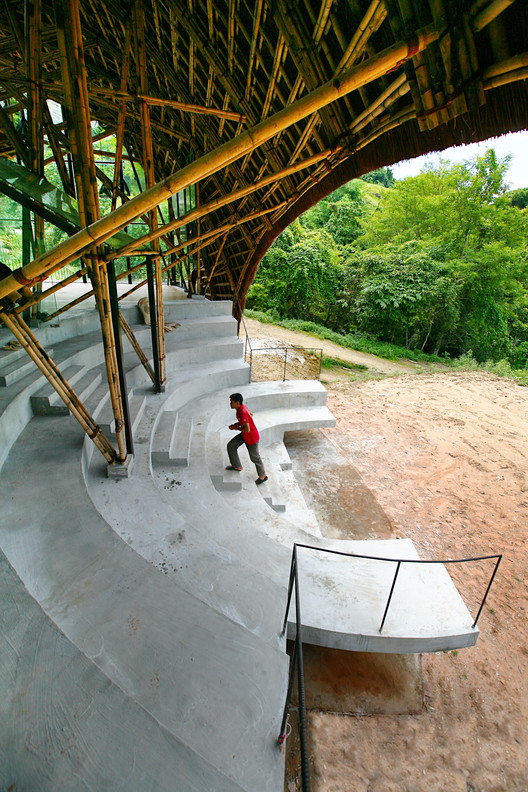Janzi Box Spark Architects
2015-10-22 20:00


架构师提供的文本描述。社区是家庭的延伸。当退休的时候,他们照看孩子们并支持他们的成员。随着社区的发展,其社会生活基础设施也在发展,为人们的习惯和行为提供了文化培训场所。公共空间是促进社区社会互动的平台。在北京设计周五周年之际,我们正在努力展示北京公共空间中最令人兴奋和最丰富的品质之一:它的自发性和活力。
Text description provided by the architects. Communities are an extension of the family. They watch over the children and support its members when retirement comes. As the community grows, so does its infrastructure for social life, providing cultural training grounds for habits and behaviours. Public spaces are the platforms that foster social interaction for communities. In the 5th anniversary of the Beijing Design Week, we are seeking to showcase one of the most exciting and rich qualities of Beijing’s public spaces: its spontaneity and dynamism.


我们决定使用一个项目,它是城市公共空间日常生活的一部分:“建子”(毽子)。汉代(公元前206年至公元220年)以来的一种传统的亚洲游戏。在一场江子比赛中,球员们用身体来防止重量级的羽毛球到达地面。从这个意义上说,“简子”是一个小项目,需要社会互动和公共空间的自发使用。在比赛过程中,它可以把一个剩余的空间变成一个令人兴奋的操场。它使社区能够团结在一起,加强社会凝聚力,同时增加如此剧烈的有氧运动所需的所有健康好处。它振兴了整个北京的许多剩余空间,这就是为什么我们必须将这一现象落实到我们的建议中来。我们认为北京设计周是一个有影响力的平台,可以在国内外展示一些北京和它的传统民间表达方式。
We decided to use an item that is part of the everyday life of public spaces in the city: The “Jianzi” (毽子). A traditional Asian game played since the Han dynasty (206 BC–220 AD). In a Jianzi game, players use their bodies to keep a heavily weighted shuttlecock from reaching the ground. In this sense the “Jianzi” is a small item that calls for social interaction and spontaneous use of public space. It can transform a leftover space into an exciting playground during the course of the game. It allows communities to coalesce, strengthening social cohesion, while adding all the health benefits that is required in such a vigorous aerobic exercise. It vitalises many residual spaces throughout Beijing and this is why it is very important for us to materialise this phenomenon into our proposal. We conceive Beijing Design Week as an influential platform to showcase, both nationally and internationally, a little bit of Beijing and its traditional folk expressions.


我们设计了一艘由15.000艘建子船组成的船,它将降落在今年北京设计周的一个新的中心-白塔西地区(白塔寺)的一个空场地上。“简子容器”是用来与玩家倒置剑子游戏的容器,通过人的感官,创造了与“简子”项目的亲密联系,不仅在身体上,而且在感性和情感层面上。
We designed a vessel composed of 15.000 Jianzi units that will land on an empty site in the Baitasi area (白塔寺), a new hub for the Beijing Design Week this year. The Jianzi Vessel is designed to invert the Jianzi game with the players, creating an intimate connection with the Jianzi Item and engaging not only in a physical but also in a perceptual and emotional level through people’s senses.


所有的建子单位都会赠送给游客,这样他们就可以通过聚在一起玩得开心来创造自己的公共空间。这有可能代表该市不同地区的15.000场建子队比赛。从这个意义上说,我们的展馆不仅坐落在它位于白塔西的地方,而且在任何用户决定要从中分一杯羹的地方。
All the Jianzi units will be given away to the visitors so they can make their own public space by getting together and having a good time. This will potentially represents 15.000 Jianzi matches in different parts of the city. In this sense our pavilion is not only located on the place where it sits in Baitasi, but wherever the users decide to take a little piece of it.


































Architects Spark Architects
Location Xicheng, Beijing, China
Category Installation
Design Team Claire Yu
Project Year 2015
Photographs Shu He
























